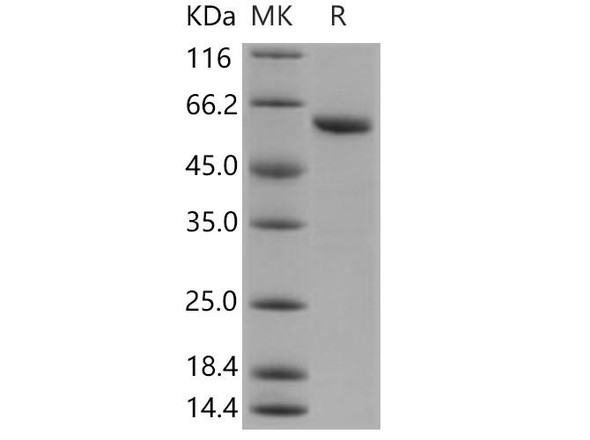Description
| Product Name: | Human TXNRD1 Recombinant Protein |
| Product Code: | RPPB2357 |
| Size: | 25µg |
| Species: | Human |
| Target: | TXNRD1 |
| Synonyms: | Thioredoxin reductase 1 cytoplasmic, TR, GRIM-12, Gene associated with retinoic and IFN-induced mortality 12 protein, KM-102-derived reductase-like factor, Thioredoxin reductase TR1, TXNRD1, GRIM12, KDRF, TR1, TXNR, TRXR1, MGC9145. |
| Source: | Escherichia Coli |
| Physical Appearance: | Sterile filtered colorless solution. |
| Formulation: | TXNRD1 Human solution (0.5mg/ml)�containing 1x PBS pH-7.4 & 10% glycerol. |
| Stability: | Store at 4°C if entire vial will be used within 2-4 weeks. Store, frozen at -20°C for longer periods of time. For long term storage it is recommended to add a carrier protein (0.1% HSA or BSA).Avoid multiple freeze-thaw cycles. |
| Purity: | Greater than 90% as determined by SDS-PAGE. |
| Amino Acid Sequence: | MGSSHHHHHH SSGLVPRGSH MYDYDLIIIG GGSGGLAAAK EAAQYGKKVM VLDFVTPTPL GTRWGLGGTC VNVGCIPKKL MHQAALLGQALQDSRNYGWK VEETVKHDWD RMIEAVQNHI GSLNWGYRVA LREKKVVYEN AYGQFIGPHR IKATNNKGKE KIYSAERFLI ATGERPRYLGIPGDKEYCIS SDDLFSLPYC PGKTLVVGAS YVALECAGFL AGIGLDVTVM VRSILLRGFD QDMANKIGEH MEEHGIKFIR QFVPIKVEQIEAGTPGRLRV VAQSTNSEEI IEGEYNTVML AIGRDACTRK IGLETVGVKI NEKTGKIPVT DEEQTNVPYI YAIGDILEDK VELTPVAIQAGRLLAQRLYA GSTVKCDYEN VPTTVFTPLE YGACGLSEEK AVEKFGEENI EVYHSYFWPL EWTIPSRDNN KCYAKIICNT KDNERVVGFH VLGPNAGEVT QGFAAALKCG LTKKQLDSTI GIHPVCAEVF TTLSVTKRSG ASILQAGC |
| Biological Activity: | Specific activity is > 15 units/mg, and was measured in a coupled assay with 5,5'-Dithiobis(2-nitrobenzoic acid)(DTNB)and NADPH. The amount of TNB generated by NADPH was measured in absorbance at 412 nm. |
TXNRD1 belongs to the selenium-containing pyridine nucleotide-disulphide oxidoreductase family, which has a conserved catalytic site of Cys-Val-Asn-Val-Gly-Cys. TXNRD1 decreases thioredoxins as well as other substrates, and participates in selenium metabolism and protection against oxidative stress. Inhibition of TXNRD1 activity serves as a potential treatment for cancer, AIDS and other autoimmune diseases as well as bacterial infections and parasitic diseases.
TXNRD1 Human Recombinant produced in E.Coli is a single, non-glycosylated,polypeptide chain containing 508 amino acids (161-647 a.a.) and having a molecular mass of 55.7 kDa. TXNRD1 protein is fused to a 20 amino acid His tag at N-terminus and is purified by standard chromatography.
| UniProt Protein Function: | TRXR1: a cytoplasmic pyridine nucleotide oxidoreductases. This protein reduces thioredoxins as well as other substrates, and plays a role in selenium metabolism and protection against oxidative stress. The functional enzyme is thought to be a homodimer which uses FAD as a cofactor. Each subunit contains a selenocysteine residue which is required for the catalytic activity. |
| UniProt Protein Details: | Protein type:EC 1.8.1.9; Nuclear receptor co-regulator; Oxidoreductase; Nucleotide Metabolism - pyrimidine Chromosomal Location of Human Ortholog: 12q23-q24.1 Cellular Component: nucleoplasm; nucleolus; cytosol Molecular Function:protein binding; thioredoxin-disulfide reductase activity; FAD binding; electron carrier activity; protein disulfide oxidoreductase activity Biological Process: response to reactive oxygen species; cell redox homeostasis; nucleobase, nucleoside and nucleotide metabolic process; nucleobase, nucleoside and nucleotide interconversion; cellular lipid metabolic process; signal transduction |
| NCBI Summary: | This gene encodes a member of the family of pyridine nucleotide oxidoreductases. This protein reduces thioredoxins as well as other substrates, and plays a role in selenium metabolism and protection against oxidative stress. The functional enzyme is thought to be a homodimer which uses FAD as a cofactor. Each subunit contains a selenocysteine (Sec) residue which is required for catalytic activity. The selenocysteine is encoded by the UGA codon that normally signals translation termination. The 3' UTR of selenocysteine-containing genes have a common stem-loop structure, the sec insertion sequence (SECIS), that is necessary for the recognition of UGA as a Sec codon rather than as a stop signal. Alternative splicing results in several transcript variants encoding the same or different isoforms. [provided by RefSeq, Jul 2008] |
| UniProt Code: | Q16881 |
| NCBI GenInfo Identifier: | 172046253 |
| NCBI Gene ID: | 7296 |
| NCBI Accession: | Q16881.3 |
| UniProt Secondary Accession: | Q16881,Q6FI31, Q6VB40, Q6VB41, Q6VB42, Q6VBP2, Q6VBP3 B7Z1F4, B7Z3Y8, B7Z904, E9PMY9, F5H780, |
| UniProt Related Accession: | Q16881 |
| Molecular Weight: | 50,873 Da |
| NCBI Full Name: | Thioredoxin reductase 1, cytoplasmic |
| NCBI Synonym Full Names: | thioredoxin reductase 1 |
| NCBI Official Symbol: | TXNRD1�� |
| NCBI Official Synonym Symbols: | TR; TR1; TXNR; TRXR1; GRIM-12�� |
| NCBI Protein Information: | thioredoxin reductase 1, cytoplasmic; oxidoreductase; thioredoxin reductase TR1; thioredoxin reductase GRIM-12; KM-102-derived reductase-like factor; gene associated with retinoic and IFN-induced mortality 12 protein; gene associated with retinoic and interferon-induced mortality 12 protein |
| UniProt Protein Name: | Thioredoxin reductase 1, cytoplasmic |
| UniProt Synonym Protein Names: | Gene associated with retinoic and interferon-induced mortality 12 protein; GRIM-12; Gene associated with retinoic and IFN-induced mortality 12 protein; KM-102-derived reductase-like factor; Thioredoxin reductase TR1 |
| Protein Family: | Tropinone reductase |
| UniProt Gene Name: | TXNRD1�� |
| UniProt Entry Name: | TRXR1_HUMAN |










